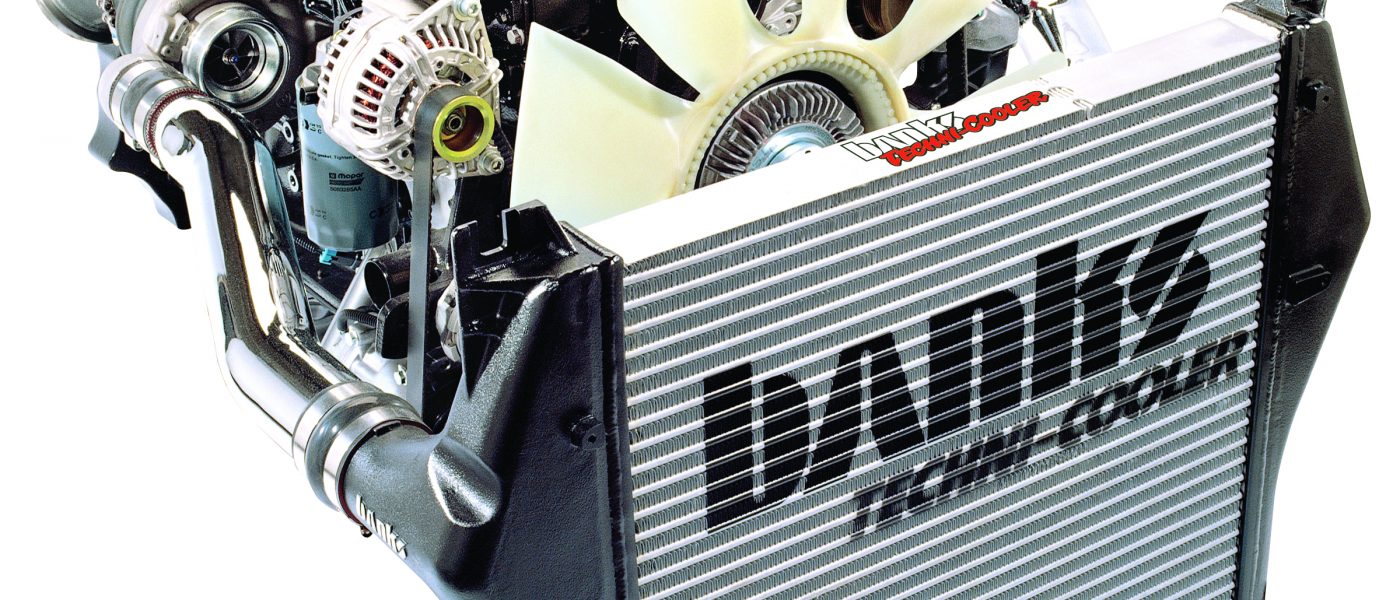Making Big Diesel Power
Dirt Sports January 2006
A 2005 Dodge Ram 3500 Quad Cab 4×4 gets a Big Hoss Bundle — with the new Banks iQ!
Project: Heavy Metal
Finding the perfect new truck is never easy. In our case it was even more of a challenge because we needed one that could do it all. From daily driver to chase truck to prerunner to tow rig our new truck had to be the ultimate in multi-tasking. The search was long and arduous but it finally came to an end when we happened across a smoking deal on a barely used 2005 Dodge Ram 3500 Quad Cab 4×4 equipped with the venerable Cummins engine. With the stout diesel mill under its hood the Dodge is an excellent tow rig. The smaller dimensions of the Dodge would make it easy to drive and park in and around our overly congested confines of Southern California. Its coil-sprung, live axle front suspension is rugged and capable of gobbling up bumps at speed or while crawling. With all of these strong attributes, the Ram would be a great multi-tasker and after some wheeling and dealing it was ours.
In stock form the Cummins produces 325 HP and 600 lb-ft of torque. While these are definitely strong numbers we are greedy bastards and wanted even more of a good thing so our first stop was to Banks Engineering. Anybody familiar with diesels is also familiar with Banks as they have been in the business of extracting more horsepower and torque from diesel engines for the last three decades. Over the years they have also built a reputation of reliably making impressive gains and that was key to us, as our Dodge will undoubtedly see its share of travel in remote areas. To make the most of the 5.9-liter Cummins diesel we decided to install the top-of-the-line Banks Big Hoss Bundle along with the trick new Banks iQ. Follow along as we dissect the components of the package along with the results.
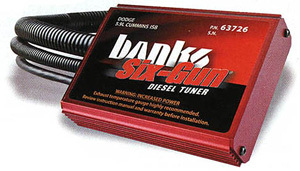
The heart of the Big Hoss Bundle is the Six-Gun Tuner, which produces the majority of power.
The Big Hoss Bundle
The Six-Gun Tuner: At the heart of the Big Hoss Bundle is the Six-Gun Tuner. Modern diesel engines are completely electronically controlled so it is no surprise that the most significant gains are from a tuner that modifies computer-determined parameters such as fuel pressure, pulse width and timing. By altering these parameters from stock the Six-Gun allows for gains up to 112 additional horsepower and 259 additional lb-ft of torque (with the Speed-Loader upgrade and airflow improvements). The Six-Gun gets its name from the ability to choose from six different power output levels that are adjustable on the fly.
The tuner is built with several important safeguards to protect the transmission and Cummins engine. Dubbed AutoRate and ActiveSafety, the two systems work together to monitor torque converter lockup, turbo behavior, transmission slip, exhaust gas temperature, coolant temperature and cold engine conditions. Should one of these variables fall out of spec or exceed limits, AutoRate will automatically pull power back to a safe level until normalcy is returned, regardless of the power setting of the Six-Gun. Once everything returns to spec, the additional power of the selected setting will be automatically restored. On top of this the Six-Gun constantly monitors itself to ensure proper function and will automatically bypass itself should it ever malfunction.
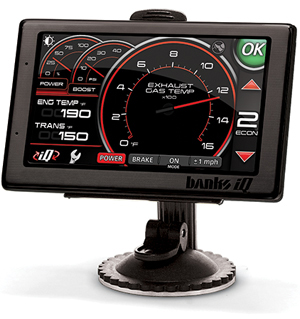
The Banks iQ features several screens along with a host of features.
The Banks iQ: The Banks iQ Dashboard PC is a very slick and trick addition to the Six-Gun Tuner. It allows for the seven different levels of power (the Banks iQ features a built-in Speed-Loader option for the seventh level) to be changed on the fly through the PC instead of using a knob. The Banks iQ also features a wealth of gauges. Boost and exhaust gas temperatures are always displayed but the user can choose from 14 other gauges including such vitals as transmission temperature, intake manifold temperature and engine temperature. Also part of the Banks iQ is the ability to set on-screen alerts with audible alarms for a specified exhaust gas temperature point (between 1100-1700 degrees), engine coolant temperature (between 150-255 degrees) and transmission temperature (between 150-255 degrees)
The Banks iQ also offers the ability to tune 16 different aspects of the Six-Gun Tuner such as accelerator pump behavior, exhaust gas temperature limit, exhaust gas temperature limit overshoot time, trans slip fuel limit, gear fuel limits and shift fuel limits. Along with this ability the Banks iQ can read and clear OBDII codes along with performing performance tests such as 0 to 60 times, 1/4-mile and 1/8-mile times as long as your speedometer is accurate. If it is not accurate, the Banks iQ can also recalibrate its own speedometer for any size tire. Banks advertises it as the ultimate interface to the Six-Gun Tuner and after using it and going through its long list of functions it’s easy to say that this is a very legitimate claim.

Besides its much larger size, the Banks Techni-Cooler features rounder and smoother end tanks to improve flow and reduce boost loss. The end tanks are also metal and not composite like the stock units.
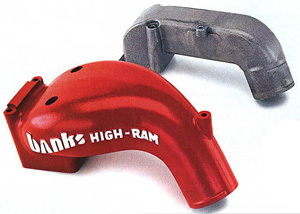
Pictured next to the stock inlet it is easy to see how the smoother shape of the High-Ram increases airflow.
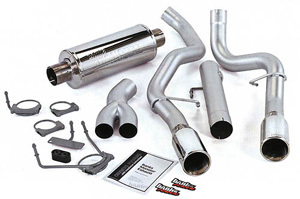
The Monster Exhaust utilizes 4-inch-diameter stainless steel tubing to increase flow.
Techni-Cooler intercooler: One of the key tasks of the intercooler is to cool compressed air coming from the turbo before it reaches the engine. Cooler air is denser and contains more oxygen, which translates to more power. Of course another benefit of cooler air going into the engine is reduced exhaust gas temperatures coming out of the engine. The Banks Techni-Cooler is 27% bigger than the stock unit to help accomplish all of this. It also features more streamlined end tanks and included with it are bigger and smoother 3-1/2-inch diameter boost tubes. The less restrictive shapes of the boost tubes and the end tanks help to move air quicker for more efficient cooling and reduce any boost loss between the turbo and engine.
High-Ram air inlet: The High-Ram is an exercise in airflow. Its much more bulbous shape along with its less-restrictive design feeds air to the engine cylinders faster. Along with moving air faster it also prevents boost loss due to restriction.
Monster Exhaust: The Monster Exhaust system’s job is to remove exhaust from the engine quicker by being less restrictive. It utilizes 4-inch stainless steel tubing along with the Monster muffler to deliver a more authoritative sound. On our Dodge it was only a cat-back system.
Ram-Air filter: A drop-in filter that uses the existing air box, the Ram-Air filter’s mission is simple: get more air to the engine than the stock unit can while doing a better job of filtering.
Testing and Result
The main focus of our article was always testing. We weren’t interested in doing a bland, step-by-step install but rather wanted to see the real results of installing the Big Hoss Bundle on our new Dodge. Plenty of time was spent on the dyno, doing performance runs and monitoring gauges.
EGTs
One of the first tests we performed was to gauge the effect of the Banks Techni-Cooler along with the other airflow improvements on exhaust gas temperature (EGT). To find out if there was a difference we installed only the Six-Gun Tuner and then performed several 1/4-mile acceleration runs at the highest power level noting peak EGTs along the way. We then installed the rest of the Big Hoss Bundle including the Texas-sized Techni-Cooler intercooler and boost tubes. After the installation was complete we went back to the same location and performed more 1/4-mile runs again at the highest level of power. We saw an average drop of 20 to 25 degrees in EGTs during these runs. While this might not sound like much it needs to be taken into account that a 1/4-mile run is very short in duration. In a more real world situation such as towing a heavy load up a long, steep grade, Banks notes that up to 100-degree drops in EGTs are possible with the Techni-Cooler and its associated components.
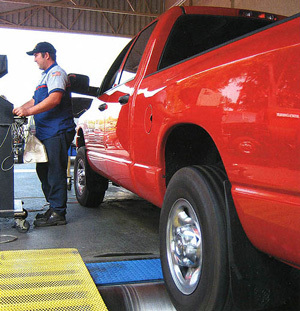
A multitude of dyno runs were performed on our Dodge to see the results of Banks modifications.
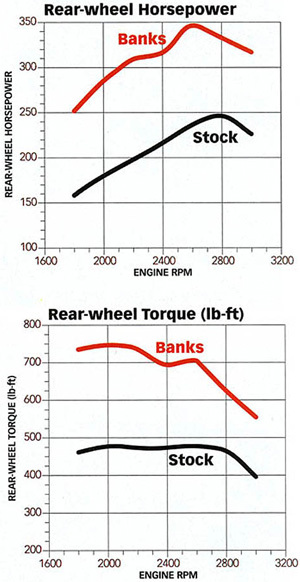
The dyno results were impressive with our Dodge producing 270 more lb-ft of torque and 111 more horsepower.
Dyno
On the dyno our Ram 3500 4×4 Quad cab short bed in stock form produced 197.9 HP at 2,200 rpm and 481.1 lb-ft of torque at 2,000 rpm at the rear wheels. After the install of the Big Hoss Bundle these numbers jumped dramatically. When set at the top level of the Six-Gun, torque increased by 270.4 lb-ft to an eye-boggling 751.5 lb-ft at 2,000 rpm. This massive jump translates to an extremely healthy 56.2% increase in torque. Gains in horsepower were just as impressive with 111.6 additional horsepower being produced at 2,200 rpm by the Big Hoss Bundle (a 56.4% increase). Needless to say the numbers are very impressive and are above Banks’ advertised gains. Looking at the dyno graphs also show how usable the new power is. Over 700 lb-ft of rear wheel torque is available from 1,800 rpm to 2,300 rpm. The plot of horsepower tells a similar story with more than 300 rear wheel horsepower available from 2,200 to 3,000 rpm.
Performance
With the gobs of new power on tap we couldn’t wait to get back to our defunct street-racing site that we used as a testing ground. In stock form our big Dodge managed a 0-60 mph run of 9.14 seconds and covered a 1/4 mile in 17.51 seconds at 82 mph. With the Six-Gun Tuner set on warp drive, the Dodge zipped from 0 to 60 mph in 7.21 seconds (1.93 seconds quicker). In the 1/4 mile the improvement was equally as impressive with the Dodge posting a 15.67 second run at 92 mph (1.84 seconds quicker and 10 mph faster). These are stellar numbers considering our Dodge weighs a rather girthy 7,000 lbs. and has the aerodynamics of a barn door yet still produces acceleration numbers similar to a Porsche Cayenne. We were also not on a perfectly groomed and level drag strip and these times are not corrected for weather.
Real World
On the street our Dodge is now a blast to drive. Simply depress the gas pedal and the Dodge feels like a freight train as the ridiculous amounts of torque push the truck forward and its occupants back into their seats. It is simply amazing that our overweight Dodge can now beat the majority of coffee-can muffler equipped Hondas that look like they rolled through Pep Boys with the crap magnet energized. Best of all the power is adjustable so when we don’t need to be schooling poseurs the Six-Gun can be adjusted to a lower setting or stock output. The Banks iQ is also easy to use and one of the slickest ways to control the Six-Gun. It also retains all of its PC functions that we capitalize on to make futile attempts to organize our chaotic lives. Our only complaint about the whole system was the exhaust, which we found to produce an annoying amount of droning in the cab. Other than that, we’re completely happy with the Big Hoss Bundle as it transformed our beast of a truck into a hot rod.
 THE BANKS BILLET TORQUE CONVERTER THE BANKS BILLET TORQUE CONVERTER Banks does not recommend towing above the third power level on the Six-Gun Tuner so we knew performing several dyno runs at its maximum setting would be pushing our luck. Compounding the problem further was that our Dodge was not getting traction on the dyno due to its abundant torque. To combat this, a 300-gallon water tank was loaded into the bed of the Dodge. The weight of the water along with the resistance of the dyno proved overwhelming for our stock torque converter. Luckily the Six-Gun monitored the minute bit of slip in the converter and pulled power back to prevent any damage. However this meant we could not get accurate dyno numbers as the stock converter would continuously slip and the Six-Gun would scale back on power to keep from damaging the converter. This scenario proved two things however. First that the stock torque converter is the weak link in the transmission and secondly that the safety features built into the Six-Gun do work. In order to get accurate numbers we decided to replace the factory torque converter with Banks’ billet torque converter. It provides more than double the torque capacity of the stock unit (1,600 lb-ft vs. 700 lb-ft) through its forged billet housing and multi-disc converter clutch. The turbine and impeller are also furnace brazed and the turbine hub is furnace brazed and hardened. Its pump drive is also made of 4130 chromoly helping it to withstand massive amounts of torque. Since its lockup clutch is slip resistant, transmission fluid temperatures stay lower helping to prolong tranny life. Once installed we had no more slipping issues and were able to dyno with the Six-Gun set on its highest level without any more problems.  |

